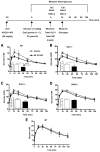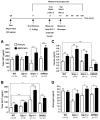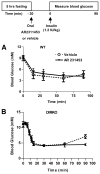GPR119 regulates murine glucose homeostasis through incretin receptor-dependent and independent mechanisms
- PMID: 21068156
- PMCID: PMC3082521
- DOI: 10.1210/en.2010-1047
GPR119 regulates murine glucose homeostasis through incretin receptor-dependent and independent mechanisms
Abstract
G protein-coupled receptor 119 (GPR119) was originally identified as a β-cell receptor. However, GPR119 activation also promotes incretin secretion and enhances peptide YY action. We examined whether GPR119-dependent control of glucose homeostasis requires preservation of peptidergic pathways in vivo. Insulin secretion was assessed directly in islets, and glucoregulation was examined in wild-type (WT), single incretin receptor (IR) and dual IR knockout (DIRKO) mice. Experimental endpoints included plasma glucose, insulin, glucagon, glucagon-like peptide-1 (GLP-1), glucose-dependent insulinotropic peptide (GIP), and peptide YY. Gastric emptying was assessed in WT, Glp1r-/-, DIRKO, Glp2r-/-, and GPR119-/- mice treated with the GPR119 agonist AR231453. AR231453 stimulated insulin secretion from WT and DIRKO islets in a glucose-dependent manner, improved glucose homeostasis, and augmented plasma levels of GLP-1, GIP, and insulin in WT and Gipr-/- mice. In contrast, although AR231453 increased levels of GLP-1, GIP, and insulin, it failed to lower glucose in Glp1r-/- and DIRKO mice. Furthermore, AR231453 did not improve ip glucose tolerance and had no effect on insulin action in WT and DIRKO mice. Acute GPR119 activation with AR231453 inhibited gastric emptying in Glp1r-/-, DIRKO, Glp2r-/-, and in WT mice independent of the Y2 receptor (Y2R); however, AR231453 did not control gastric emptying in GPR119-/- mice. Our findings demonstrate that GPR119 activation directly stimulates insulin secretion from islets in vitro, yet requires intact IR signaling and enteral glucose exposure for optimal control of glucose tolerance in vivo. In contrast, AR231453 inhibits gastric emptying independent of incretin, Y2R, or Glp2 receptors through GPR119-dependent pathways. Hence, GPR119 engages multiple complementary pathways for control of glucose homeostasis.
Figures






Similar articles
-
A role for intestinal endocrine cell-expressed g protein-coupled receptor 119 in glycemic control by enhancing glucagon-like Peptide-1 and glucose-dependent insulinotropic Peptide release.Endocrinology. 2008 May;149(5):2038-47. doi: 10.1210/en.2007-0966. Epub 2008 Jan 17. Endocrinology. 2008. PMID: 18202141
-
β-Cell Inactivation of Gpr119 Unmasks Incretin Dependence of GPR119-Mediated Glucoregulation.Diabetes. 2017 Jun;66(6):1626-1635. doi: 10.2337/db17-0017. Epub 2017 Mar 2. Diabetes. 2017. PMID: 28254842 Free PMC article.
-
Differential importance of glucose-dependent insulinotropic polypeptide vs glucagon-like peptide 1 receptor signaling for beta cell survival in mice.Gastroenterology. 2009 Dec;137(6):2146-57. doi: 10.1053/j.gastro.2009.09.004. Epub 2009 Sep 17. Gastroenterology. 2009. PMID: 19766644
-
GIP and GLP-1 as incretin hormones: lessons from single and double incretin receptor knockout mice.Regul Pept. 2005 Jun 15;128(2):125-34. doi: 10.1016/j.regpep.2004.07.019. Regul Pept. 2005. PMID: 15780432 Review.
-
The Insulin Response to Oral Glucose in GIP and GLP-1 Receptor Knockout Mice: Review of the Literature and Stepwise Glucose Dose Response Studies in Female Mice.Front Endocrinol (Lausanne). 2021 May 27;12:665537. doi: 10.3389/fendo.2021.665537. eCollection 2021. Front Endocrinol (Lausanne). 2021. PMID: 34122340 Free PMC article. Review.
Cited by
-
Targeting lipid GPCRs to treat type 2 diabetes mellitus - progress and challenges.Nat Rev Endocrinol. 2021 Mar;17(3):162-175. doi: 10.1038/s41574-020-00459-w. Epub 2021 Jan 25. Nat Rev Endocrinol. 2021. PMID: 33495605 Review.
-
Circulating fatty acids and endocannabinoidome-related mediator profiles associated to human longevity.Geroscience. 2021 Aug;43(4):1783-1798. doi: 10.1007/s11357-021-00342-0. Epub 2021 Mar 1. Geroscience. 2021. PMID: 33650014 Free PMC article.
-
GLP-2 delays but does not prevent the onset of necrotizing enterocolitis in preterm pigs.J Pediatr Gastroenterol Nutr. 2013 Jun;56(6):623-30. doi: 10.1097/MPG.0b013e318286891e. J Pediatr Gastroenterol Nutr. 2013. PMID: 23343934 Free PMC article.
-
Investigational anti-hyperglycemic agents: the future of type 2 diabetes therapy?Endocrine. 2013 Aug;44(1):47-58. doi: 10.1007/s12020-013-9884-3. Epub 2013 Jan 25. Endocrine. 2013. PMID: 23354728 Review.
-
Medicinal Plants Qua Glucagon-Like Peptide-1 Secretagogue via Intestinal Nutrient Sensors.Evid Based Complement Alternat Med. 2015;2015:171742. doi: 10.1155/2015/171742. Epub 2015 Dec 15. Evid Based Complement Alternat Med. 2015. PMID: 26788106 Free PMC article. Review.
References
-
- Pederson RA, Schubert HE, Brown JC. Gastric inhibitory polypeptide. Its physiologic release and insulinotropic action in the dog. Diabetes. 1975;24:1050–1056. - PubMed
-
- Drucker DJ. The biology of incretin hormones. Cell Metab. 2006;3:153–165. - PubMed
-
- Deacon CF. Therapeutic strategies based on glucagon-like peptide 1. Diabetes. 2004;53:2181–2189. - PubMed
-
- Drucker DJ, Nauck MA. The incretin system: glucagon-like peptide-1 receptor agonists and dipeptidyl peptidase-4 inhibitors in type 2 diabetes. Lancet. 2006;368:1696–1705. - PubMed
-
- Ahrén B. Islet G protein-coupled receptors as potential targets for treatment of type 2 diabetes. Nat Rev Drug Discov. 2009;8:369–385. - PubMed
Publication types
MeSH terms
Substances
Grants and funding
LinkOut - more resources
Full Text Sources
Other Literature Sources
Medical
Molecular Biology Databases

